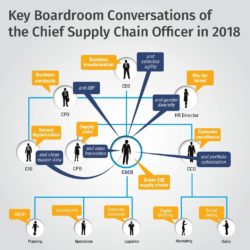Pharmaceutical company MSD achieves one-number planning

A key characteristic of integrated business planning (IBP) is the involvement of the financial director in the monthly planning cycle. Sometimes, the financial director may even be the initiator of an integrated planning approach – as in the case of MSD’s animal health division, according to Ralf Neumerkel during his presentation at the Global Integrated Business Planning Summit held in the Dutch town of Badhoevedorp. He succeeded in getting three different departments together at the same table: “Suddenly everyone understood the source of their own problems.”
During his presentation, Neumerkel, Finance Director Accounting to Reporting at pharmaceutical company MSD, displayed a graph showing three widely disparate curves, all three of which represented the demand forecast for the same new medicine. The bottom curve was the R&D department’s forecast, the middle one was from Supply Chain and the top curve was the forecast by the ever-optimistic Sales & Marketing department. All three departments are based in Germany and form part of MSD’s animal health division. “There was no contact between the three departments, which led to three very different plans with absolutely no alignment. As a result, we often had too little or too much stock, or the R&D department would be working on developing a new medicine for which there was no market interest whatsoever,” explained Neumerkel.
That situation was the norm until the animal health division experienced a period of rapid growth, with the average revenue growth rate suddenly increasing from a manageable 4 to 5 percent to a more challenging 10 to 12 percent per year. “Animal health suddenly became the fastest-growing division within MSD and attracted more attention from the executive board. The supply chain came under growing pressure and there was a greater need for more structure and alignment,” continued Neumerkel. He took the initiative and brought all three departments together at the same table for the annual budget discussions. “Prior to that, the three departments had always held their annual budget discussions separately, with each department having its own financial manager. There wasn’t any alignment until the very end of the process, by which time Sales and Marketing had already set their targets and Supply Chain had completed its capacity planning.”
Mutual trust
Now, the three departments were forced to listen to one another – and the effect was immediately apparent. Everyone involved suddenly understood the source of their problems. “We now have an agile organization that reaches collaborative agreements about the budget figures and the targets, yet each separate department remains responsible for how they achieve those targets. Our production organization is now more efficient than ever, we have less write-down of inventory and R&D is quicker to cease its development work on products for which there is no market interest.”
Mutual trust is important, emphasized Neumerkel: “Everyone involved has to accept that one-number planning makes sense and they have to believe that they can have an impact on those plans. But the lower down you go in the organization, the harder it becomes to stick to a joint plan, because people at lower levels of the organization have their own specific tasks and interests that they want to see reflected in the plan. It’s tempting to look at too many details and to keep analysing new scenarios, but you should ask yourself whether all those activities really do add anything worthwhile. Keep it simple. It’s better to focus on product groups that on individual products.”
Involve HR
Earlier on at the Global Integrated Business Planning Summit, Markus Bornfleth, Senior Expert IBP from Capgemini, underlined the importance of investing in change management: “There’s no point in spending millions on setting up a new integrated planning process if you don’t have people who are willing and able to participate in that process. Involve other departments too, such as HR. It’s sometimes necessary to amend people’s job descriptions,” he stated. He went on to compare IBP to an orchestra: “If you change an orchestra’s repertoire, it’s wise to let the audience in on your plans too. The first time you hear it, a new piece of music can sometimes just sound like a jumble of noise. It takes a couple of listens to truly appreciate it.”
Evelyn Younes, Regional Planning & Logistics Manager at General Mills, also stressed the importance of the HR department. “It’s a big challenge for HR to put the right people with the right skills in the right roles,” she said. She mentioned the acronym CARE, which stands for Clarity, Alignment, Resources and Enable. “Create clarity about the tasks and responsibilities of everyone involved. Ensure alignment between the relevant departments. Invest in people who have the required competencies, and spend money on talent development. And take a critical look at the organizational culture and its existing people and structures. Do they enable IBP, or are they standing in its way?”










